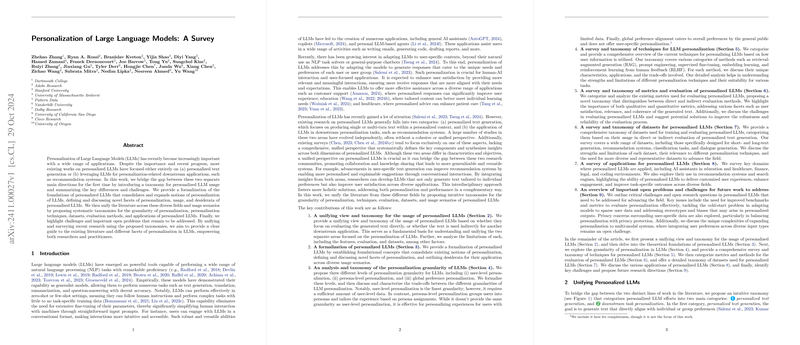Overview of "Personalization of LLMs: A Survey"
The paper "Personalization of LLMs: A Survey" explores the burgeoning field of personalization within LLMs and aims to consolidate existing research while identifying areas for further exploration. This comprehensive survey articulates a critical synthesis of methods, challenges, and applications related to personalizing LLMs, seeking to enhance user interaction by aligning outputs with individual or group-specific preferences.
Main Contributions and Structure
The authors establish a unifying taxonomy to categorize personalization efforts for LLMs, distinguishing between direct personalized text generation and its application for downstream tasks, such as recommendations. A detailed portrayal is provided on how these lines of research, though typically segregated, share foundational principles and methodologies. This cross-disciplinary approach promotes a nuanced understanding of personalization that fosters enhanced collaboration across AI research communities.
Personalization Granularity
Personalization is dissected into three levels of granularity—user-level, persona-level, and global preferences—each offering unique benefits and challenges. User-level personalization involves crafting models that adapt to individual user preferences, offering highly tailored interactions. Persona-level personalization aggregates preferences across user groups sharing similar traits, providing scalable customization. Lastly, global preference alignment addresses universally accepted norms and biases. This tiered approach allows for adaptive strategies, balancing precision and scalability.
Techniques for Personalization
The authors categorize personalization approaches by the format in which user information is employed:
- Retrieval-Augmented Generation (RAG): This method integrates external knowledge to tailor model outputs. Sparse and dense retrieval techniques operationalize this approach by pulling relevant content based on user-specific contexts.
- Prompting: Crafting contextually rich prompts that incorporate user preferences enhances the model's response generation, supporting both direct and role-specific personalization.
- Representation Learning: This technique focuses on adjusting model parameters, either entirely or through parameter-efficient fine-tuning, to encapsulate user-specific behaviors.
- Reinforcement Learning from Human Feedback (RLHF): Using user feedback as reinforcement signals, RLHF aligns LLMs with personalized preferences, optimizing the model's utility for diverse user populations.
Evaluation and Datasets
The evaluation of personalized LLMs is bifurcated into intrinsic methods, which assess text generation quality directly, and extrinsic evaluations that rely on downstream task performance. A taxonomy of datasets is proposed, differentiating those containing user-authored texts, pivotal for direct personalization assessment, from datasets geared towards indirect LLM application evaluations.
Applications and Challenges
Personalized LLMs are applicable across domains such as education, healthcare, finance, and legal systems, each posing unique challenges and benefits. These models hold promise in enhancing decision-making, providing tailored advice, and improving user satisfaction through personalized interactions.
However, the paper identifies unresolved challenges, including:
- Cold-Start Problem: Addressing scenarios with minimal user data.
- Bias Mitigation: Ensuring fair and unbiased outputs reflective of diverse perspectives.
- Privacy: Balancing the enhancement of user experiences with the protection of personal data.
- Benchmark Development: Creating robust outlines to reliably assess personalization's effectiveness.
Conclusion and Future Directions
The paper encapsulates the complexity and potential of personalizing LLMs, emphasizing the importance of interdisciplinary collaboration and the development of dynamic, adaptive systems. The field is positioned for substantial advancements through the exploration of hybrid strategies, enhanced data utilization, and the alignment of model capabilities with comprehensive ethical standards. The proposed frameworks and taxonomies present a foundation for future research aimed at refining the personalization landscape within LLMs, driving innovation towards socially responsible AI solutions.
